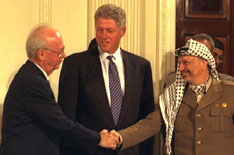Uncertainty Reigns:
The years following the Oslo process showed some conciliatory outcomes, including an Israel-Jordan peace treaty in 1994 and withdrawal of Israeli troops from portions of Gaza and the West Bank. Legislative elections of the newly formed Palestinian National Authority (PNA) were won by the Fatah faction, conferring upon Arafat the role of rais, or president. But the most contentious long-term issues — namely the question of a future state of Palestine, the status of Jerusalem, and the fate of Palestinian refugees and their descendents — remained unresolved.
Many Palestinians regarded the ongoing settlement, and related proliferation of roads and other security provisions for Israelis, as acts of aggression that undermined the integrity of a future Palestinian state. Many on the Israeli right wing saw the Oslo process as the forfeiture of God-given land and appeasement of those committed to the destruction of Israel. Their anger took shape in the massacre of 30 Muslims at prayer in Hebron in 1994 and the assassination of Prime Minister Yitzhak Rabin in 1995; though the perpetrator in each case was a lone gunman, some religious extremists embraced the acts. The familiar dynamic of Israeli settlement deeper into the West Bank and bombing campaigns by Palestinian groups would continue to inflame passions on both sides.
The mid and late 1990s saw a prolonged deadlock in the peace process. Yet, with pressure from the U.S., limited progress was achieved in the Wye River Memorandum, which pledged Israel to troop withdrawals and the PNA to honor its obligations under the Oslo agreements, including better policing of militants and reductions of weapons stockpiles. Another push toward resolution, in 2000, foundered on fundamental issues such as Israel’s insistence on annexation of portions of the Occupied Territories and the Palestinian demand of the full “right of return” of millions of refugees to Israel proper, an influx almost certain to overwhelm the Israeli state.
Amidst frustration on the part of both Israelis and Palestinians at years of negotiations with few tangible results, veteran Israeli rightist Ariel Sharon returned to the political stage. Sharon’s visit in September 2000 to the Temple Mount in Jerusalem — also the Muslim holy site of Al-Aqsa Mosque — triggered Palestinian protests that escalated into a prolonged uprising known as the Al-Aqsa intifada. Soon after, Israel’s right wing took power with Sharon as prime minister, bringing a new emphasis on tough policies.
The unfolding conflict further reinforced each party’s fear of and bitterness toward the other. After a series of attacks killed nearly 100 Israeli civilians in March 2002, Israel raided or re-occupied much of the West Bank, uncovering evidence linking Arafat and other Palestinian officials to terror groups and activities. Israeli raids at the Jenin refugee camp in April 2002 led to accusations of an Israeli massacre; in more than a week of violence, 52 Palestinians were killed there, at least 22 of them civilians. (In a report on Jenin, Human Rights Watch cited specific cases of unlawful killings by the Israeli military, but concluded that no massacres occurred.)
Nonetheless, 2002 saw important international developments toward a consensus regarding the most basic elements of a Mideast peace plan. The “Quartet” — the U. S., Russia, the United Nations, and the European Union — put forward a “roadmap” as the framework for progress toward peace. An evolving document, the roadmap came to incorporate a proposal by Saudi Crown Prince Abdullah, agreed to by the Arab League, pledging an end to the long war against Israel in return for Israel’s withdrawal from the Occupied Territories and Golan and an as-yet-unspecified resolution to the Palestinian refugee problem. The U.N. proposed a Palestinian state alongside Israel, echoed in June by U.S. President George W. Bush.
Other initiatives toward peace have begun. A non-binding, unofficial, yet possibly important peace agreement has been reached: the Geneva Accord, a detailed plan for resolving the thorniest issues of the conflict, including the fate of Jerusalem, the future of the Israeli settlements, and the Palestinian right of return. It was negotiated by Israelis and Palestinians who are politically influential, but do not represent the recognized leadership of either side. The Israeli government has denounced the agreement, as have Palestinian militants. Nevertheless, generally favorable remarks from officials as disparate as the U.S. Secretary of State Colin Powell and Yasser Arafat, and limited support from civilians on both sides, suggest that it may have some potential to shape a future peace.
Meanwhile, Israel’s Likud leadership has largely pursued strategies that it can execute on its own terms. Two of these are ideas initially proposed by Labor politicians in recent elections: a “security barrier” dividing Israeli and Palestinian lands, and the unilateral withdrawal from parts of the Occupied Territories.
As of the summer of 2004, many important factors hold the Mideast peace process in a highly uncertain state. Sharon’s governing coalition has seen opposition from within, and the future may bring a new coalition — or new elections. Meanwhile, years of conflict and corruption have so weakened the Palestinian Authority that it is challenged to even maintain basic law and order in its territory, much less compel armed extremists to acquiesce to peace with Israel. A final source of uncertainty is the U.S. campaign in Iraq and the broader “war on terror,” both of which, at the very least, have shifted international attention from a conflict that for so long held center stage.
Top photo: Sa’ar Ya’acov, Israeli Government Press Office
- Previous: 1973 – 1993



